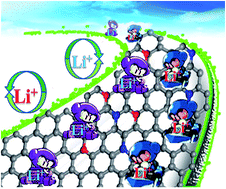Crumpled nitrogen- and boron-dual-self-doped graphene sheets as an extraordinary active anode material for lithium ion batteries†
Abstract
A novel three-dimensional, interconnected conducting layer network, comprised of crumpled nitrogen- and boron-dual-self-doped graphene sheets (NBGs) with an ultrahigh content of 7.72 at% nitrogen and 7.18 at% boron, has been synthesized through one-step thermolysis, using a borane-tert-butylamine complex as a precursor. The unique self-assembled 3D network structure offers shortened tunnels for lithium ion and electron transport and conduces the adsorption/desorption of lithium ions. As an anode material, NBGs-1000 reveals a high reversible capacity of up to 909 mA h g−1 and an excellent discharge capacity of 877 mA h g−1 after 125 cycles. It also exhibits a remarkable rate performance, including large capacities of 429 mA h g−1 and 318 mA h g−1 at 1 A g−1 and 2 A g−1, respectively. In contrast, a commercial graphite electrode has a capacity of less than 50 mA h g−1 at 1 A g−1. This demonstrates that crumpled NBGs are an extraordinary active anode material exhibiting a high capacity and good stability for lithium ion batteries, owing to their large surface area, heteroatomic defects, and the unique crumpled structure.


 Please wait while we load your content...
Please wait while we load your content...